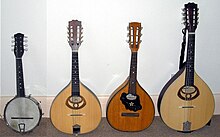

The mandolin-banjo is a hybrid instrument, combining a banjo body with the neck and tuning of a mandolin. It is a soprano banjo.[1] It has been independently invented in more than one country, variously being called mandolin-banjo, banjo-mandolin, banjolin and banjourine in English-speaking countries,[2] banjoline and bandoline in France,[3] and the Cümbüş in Turkey.[4]
The instrument has the same scale length as a mandolin (about 14 inches); with 4 courses of strings tuned identically to the violin and mandolin (low to high: GDAE). The movable bridge stands on a resonant banjo-like head typically 10 inches in diameter and currently usually made of plastic. Originally heads were made of skin and varied in diameter to as small as five inches. Larger heads were favored, however, as they were louder, and thus more audible in band settings.
- ^ "About Banjolins". Banjolin.co.uk. Retrieved 19 April 2021.
- ^ "The Irish Tenor Banjo by Don Meade" (PDF). Blarneystar.com. Retrieved 19 April 2021.
- ^ Salvador Leonardi Method for the Banjoline or Mandoline-Banjo
- ^ "Cumbus Means Fun! The Story of a 20th Century Instrument". Rootsworld.com. Retrieved 19 April 2021.